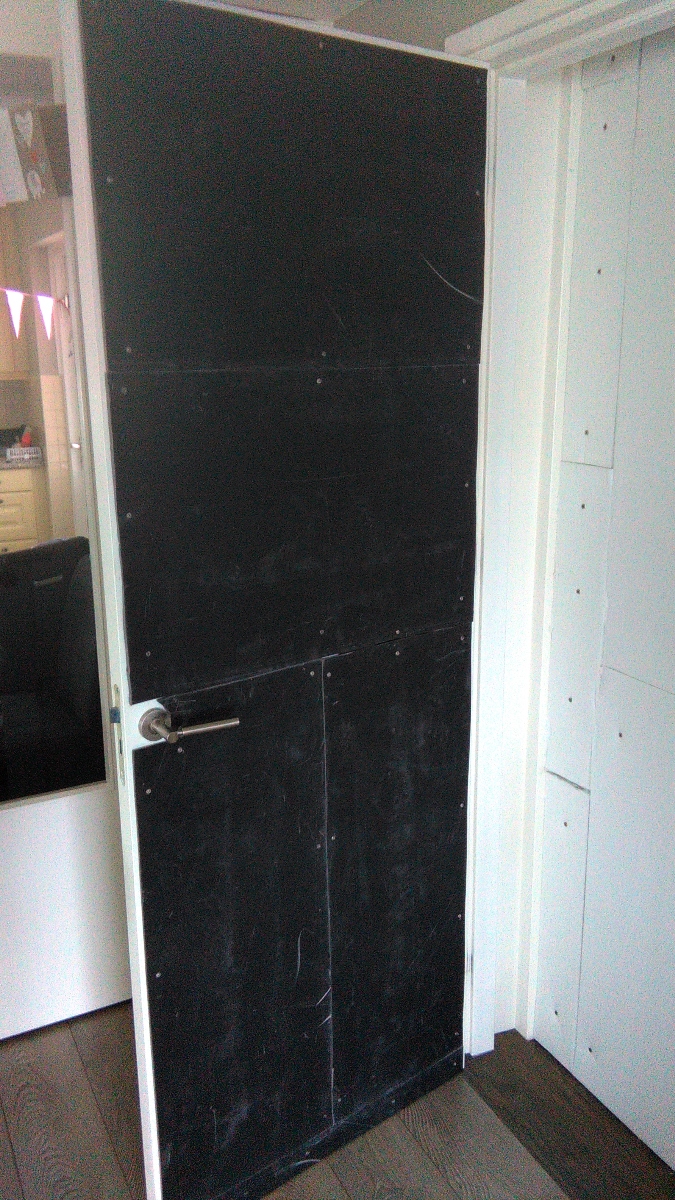A standard entrance door of a room generally poorly insulates sound: both speech and music sound penetrate easily. This is due to the lack of mass (weight) in the door leaf and the poor sealing at the floor, especially when a sill is missing.
The solution
The solution is relatively simple. Make the door leaf as heavy as possible with Isomat TS and ensure a good sealing of the door. The step-by-step plan below explains the method for insulating your door.
- Step 1: Preparing the door
Insulating the door is easiest when you take the door out of the frame. Place the door with the side that needs to be insulated upwards. Depending on the type of Isomat you will apply and the number of layers, the door will weigh at least 8 or 14 Kg per square metre more. So, additional hinges need to be added to keep the door tightly closed and safe. Make sure the door has at least four hinges, but five hinges are preferable.
- Step 2: Prepare and apply Isomat
Now that the extra hinges have been applied, you can cut the Isomat plates to size with a sharp pocketknife. The entire door leaf has to be equipped with Isomat TS8 or TS14. Once you have customised the Isomat, you apply contact glue to the Isomat and the door and leave it for about five minutes. After this, you can attach the Isomat to the door. Make sure to press it firmly in order to avoid air bubbles. The curing of the glue takes about twelve hours in total, so we advise to secure the Isomat on the long sides with three screws, totalling six screws per plate. Make sure you have sufficient ventilation during the process!
- Step 3: Finishing Isomat
Isomat is an industrial product and needs to be finished. Ideally, this is done by applying a sheet of plywood to the Isomat. Pay attention to the thickness of this material, so that you do not get into trouble with a door that suddenly happens to be too thick at the side of the hinges. In general, a plate thickness of up to 8 mm shouldn't result in any problems. Provide a sheet of plywood that is the same size as the door leaf and glue and screw it to the Isomat. Then paint the wooden plate with a colour of your choice. In this way, you can't see the Isomat, a practical tip for rental properties. The type of wood is irrelevant with regards to acoustics. - Step 4: Sealing seams and cracks
A well-insulating door also has to close of well. High-frequency noise can easily pass through cracks between door and frame and underneath the door. Mount a door rubber in the frame and sill to avoid sound leaks. If there is no sill available, then a ‘EllenMatic Drop Seal’. A drop seal closes the seam between the door and the floor, preventing sound leakage and drafts across the floor.
A door insulated with Isomat TS Insulation Board
Customer review
We received the following response to the step-by-step plan from a satisfied customer:
I just wanted to let you know that we are very satisfied with your insulation plan. Due to business only a draft strip and brush were applied at the bottom of the door. This only helped a little bit. We ordered and placed the materials a few weeks ago. Now a few months have gone by, and I dare to say that the sound has decreased by 75 percent. I'm very satisfied!
Please note
Deck doors with a steel box frame, often only containing two hinges, should be equipped with maximally one layer of Isomat TS8, not the heavier type TS14. This type of door is less strong and usually cannot be equipped with additional hinges. It is better to replace these types of doors with a complete door set, as the frames themselves may also leak a lot of noise.
Required insulation materials
- Isomat TS: Isomat TS14 or TS8 customised to the size of the door.
- Zettex glue: Double-sided application. One sprayer per door side.
- Elton EllenMatic Fall seal: For a perfect closing of the floor.
To be purchased yourself
- Plywood or plywood for finishing the Isomat.
- Screws with a flat head, six pieces per Isomat plate.
- Lacquer for finishing the plywood or plywood sheet.
Complete door set
Replacing your door with a complete door set is the optimal solution. These doors have been developed and tested to block as much noise as possible. There are two types of door sets:
- Wooden sound insulating door MH42, Complete door set incl. mounting devices, built-in drop sill and frame, insulation value 42 dB(a).
- Steel sound insulating door SD47, Complete door set incl. mounting devices, pre-mounted frame and exception.log equipped with a double built-in drop seal, insulation value 47 dB(a).
Questions? 
Do you have any questions about this topic? Please feel free to contact us, we will be happy to help you on your way.

 Sound Absorption
Sound Absorption  Sound Insulation
Sound Insulation  Vibration Isolation
Vibration Isolation  Silent Ventilation
Silent Ventilation  Accessories
Accessories  Thermal & Acoustic Insulation
Thermal & Acoustic Insulation 